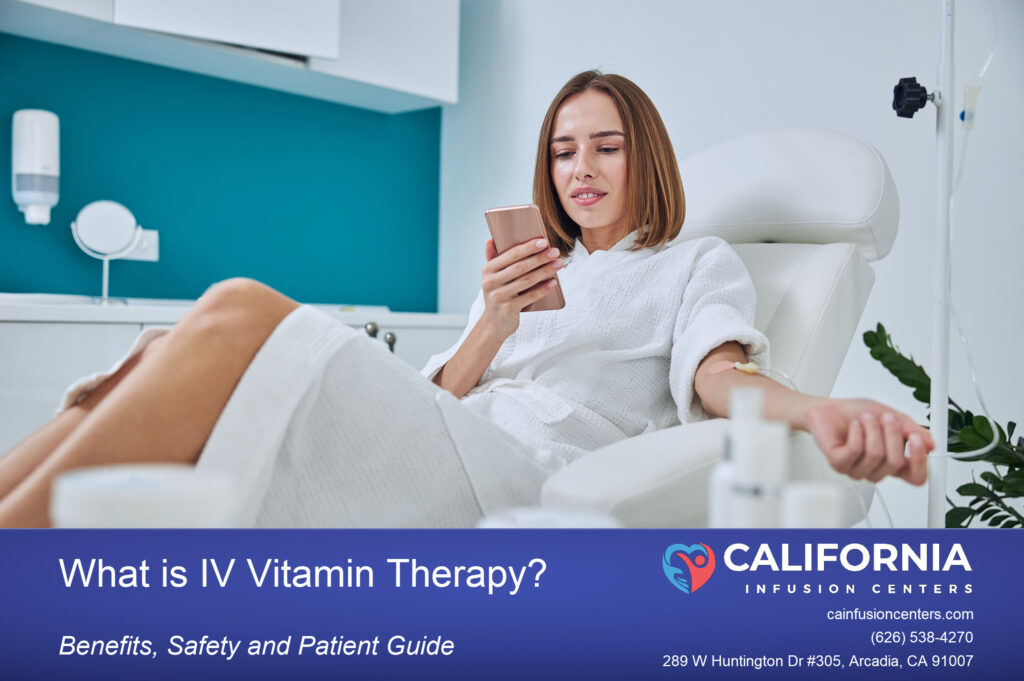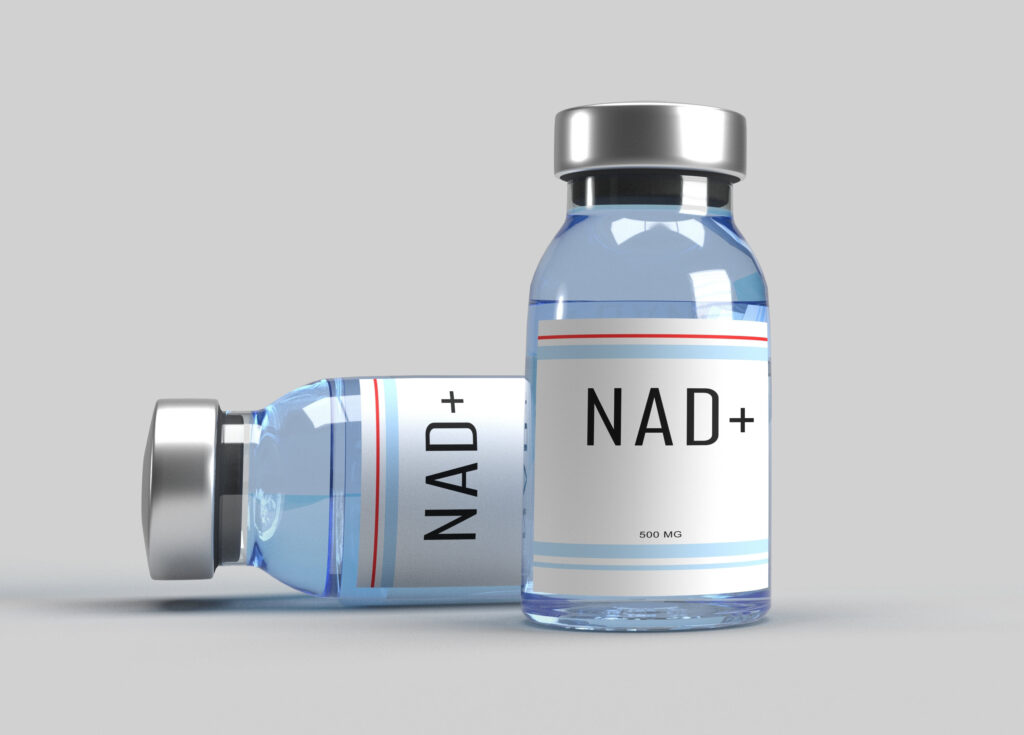Home » IV Vitamin Therapy » What Is IV Vitamin Therapy? Benefits, Safety and Patient Guide

Resource Contents
IV vitamin therapy (also called intravenous vitamin therapy, vitamin infusion therapy or an IV vitamin drip) is the practice of delivering vitamins, minerals and electrolytes directly into your bloodstream through a sterile IV line.
By bypassing the gut, nutrients reach circulation at predictable concentrations, which is why IV administration is used in hospitals for conditions like dehydration, micronutrient deficiencies and malabsorption disorders.
In wellness settings, IV vitamin therapy is offered to support energy, hydration, and immune health, although the strength of evidence varies by use case.
Learn more about how our clinic provides this service on our Vitamin Therapy page.

An IV catheter is placed into a vein in your arm. A bag containing sterile fluids with vitamins and minerals flows by gravity or pump over 30 to 60 minutes. Because there is no digestion or first-pass metabolism, IV delivery achieves near 100 percent bioavailability for the nutrients infused. This pharmacokinetic advantage is the core rationale for IV therapy and is well established in clinical pharmacology.
Typical wellness formulations may include vitamin C, B-complex, B12, magnesium, calcium, trace minerals and occasionally amino acids or antioxidants such as glutathione. Medical protocols can look different – for example, IV iron therapy or physician-directed high-dose vitamin C in research settings.
The exact composition, rate and total dose should always be individualized and ordered by a qualified clinician.
A common question is: how does IV vitamin therapy compare with simply taking a multivitamin?
With oral supplements, the digestive tract and liver limit and modulate how much ends up in your bloodstream. Absorption can be reduced by interactions with food, gastrointestinal conditions and dose limits for specific transporters in the gut. With IV therapy, nutrients enter circulation immediately, allowing higher and more reliable serum levels – which is why IV routes are used when rapid or complete delivery is required.
That pharmacokinetic edge does not automatically mean better outcomes for healthy people. For many wellness claims (such as more energy, stronger immunity or faster recovery), the clinical evidence is mixed or limited, and large guideline groups caution against routine use in people without a documented deficiency or medical indication (See: MSD Manual on Myers’ Cocktail).
When you see claims like “oral vitamins only absorb 20 to 30 percent,” know that hard numbers vary by nutrient and by person. What matters is whether higher blood levels translate to outcomes you care about.
If you have a condition that impairs absorption from the gut, IV delivery can be clinically appropriate. Examples include inflammatory bowel disease, celiac disease, short bowel syndrome or chronic vomiting. In these cases, the therapeutic goal is to correct or prevent deficiencies with a route you can actually absorb. That is fundamentally different from using IVs as a convenience or wellness boost when oral intake is adequate.

Patients often ask: Are IV drips good for you? Are IV drips safe? Do IV drips work?
The answer depends on why you are getting the drip, what’s in the bag, and who is administering it.
These are situations where IV delivery is standard care or actively studied, typically under physician supervision, with pharmacy-prepared solutions and protocolized monitoring.
Hydration and electrolytes for dehydration when oral intake is not possible or effective
IV iron for proven iron deficiency when oral iron fails or is not tolerated
Parenteral vitamins for documented deficiencies or malabsorption
Investigational high-dose vitamin C in defined settings such as oncology or critical illness (mixed findings, specialist oversight required)
These are consumer-facing services aimed at energy, immunity, recovery or skin health. Popular blends include the Myers’ Cocktail, vitamin C infusions and glutathione add-ons. Small studies and case reports exist, but major references describe the evidence as insufficient for broad claims in healthy adults (See: Medical News Today on IV Therapy).
If you pursue wellness IVs, prioritize clinical standards that mirror medical settings. Clinics like ours provide oversight from licensed providers, use sterile compounding and ensure patient safety throughout the process.

Not across the board. Some people report short-term benefits like feeling hydrated or energized, which may reflect fluid replacement, placebo effects or correction of a mild deficiency. Rigorous trials showing durable benefits for healthy people are limited.
When prepared and administered by trained clinicians using sterile technique and proper screening, risks are low but not zero. Potential complications include vein irritation, infection, fluid overload, allergic reactions and interactions with medications. Quality varies widely among retail locations, which is why reputable medical oversight like that available at California Infusion Centers matters.
People with documented deficiencies, malabsorption or specific physician-directed goals may benefit from the IV route. For general wellness in otherwise healthy adults, leading references remain cautious and recommend discussing risks, alternatives and expected outcomes with a licensed provider.
To explore if IV therapy is right for you, visit our Vitamin Therapy page or book a consultation.
Any IV carries real but manageable risks. Safety depends on sterile compounding, proper screening, correct dosing and qualified staff using evidence-based protocols.
Academic and public health sources stress that while risks are generally low in trained hands, complications can occur if preparation or technique is poor. These include vein irritation, infiltration, infection, allergic reactions, fluid overload and drug-nutrient interactions.
Choose clinics that practice the same standards you would expect in a medical office.
All compounded sterile products should follow United States Pharmacopeia standards for sterile compounding. USP <797> sets requirements that reduce contamination and infection risk, including cleanroom conditions, aseptic technique and beyond-use dating. Ask where and how your infusion bags are prepared, and by whom. (See: AANA USP General Chapter <797>)
Clinical staff should follow CDC injection safety guidance at every step. Single-use needles and syringes must never be reused. Multi-dose vials should be handled carefully to prevent cross-contamination. Hand hygiene, appropriate skin prep and closed systems reduce risk.
A clinician should review your medical history, medications, allergies and goals before approving any IV. Vitals should be checked before and after. During the drip, staff should monitor comfort, infusion rate and any signs of reaction. Emergency supplies and protocols must be on site.
In California, registered nurses practice under the Nursing Practice Act and Board of Registered Nursing regulations, including standardized procedures when performing delegated medical functions.
IV insertion and administration of fluids or medications fall within RN practice when competency is documented, a valid prescriber order is in place and facility policies are followed.
Physicians, physician assistants, nurse practitioners and other authorized providers order therapies and determine indications, while RNs implement those orders and monitor patients.
Nurse practitioner authority is evolving under AB 890, with most still practicing under standardized procedures and some gaining expanded independent practice. This structured framework of orders, standardized procedures and competency validation helps ensure IV therapy is safe.
You should know exactly what is in your bag, why it was chosen and the dose. Staff should explain potential interactions, such as high-dose vitamin C with certain kidney conditions, or magnesium in people with cardiac conduction issues. If you are pregnant, breastfeeding or managing chronic disease, ingredient selection should involve your primary clinician.

People with documented micronutrient deficiencies, malabsorption or conditions that limit oral intake may benefit from IV delivery. Examples include inflammatory bowel disease flares, chronic vomiting, short bowel syndrome or intolerance to oral iron.
Patients who need rapid rehydration after illness are also candidates when evaluated by a clinician.
People with advanced kidney disease, heart failure or a history of allergic reactions to IV components need careful screening. High-dose vitamin infusions may not be appropriate in G6PD deficiency or certain metabolic disorders. If you are on chemotherapy or immunotherapy, coordinate any IV vitamins with your oncology team to prevent interactions. Large medical sources and public health guidance emphasize that wellness IVs should not replace evidence-based care.
NAD+ IV therapy is popular for anti-aging and recovery.
Preliminary evidence exists, but broad claims remain unproven.
Clinics should explain the state of the science and obtain informed consent that reflects uncertainty.

IV vitamin therapy is safe when the right patient receives the right formulation in a medically supervised setting that follows sterile compounding, USP <797> and injection safety rules.
It becomes risky when preparation is sloppy, screening is skipped or marketing drives decisions more than medicine.
An honest clinic will help you weigh benefits against risks, then personalize a plan that fits your health goals.
Patients exploring “IV vitamin therapy benefits” or asking “do IV drips really work” usually want to know what conditions or goals are best suited for this approach. IV vitamin therapy is not a cure-all, but in the right circumstances it can be supportive.
One of the top reasons people seek vitamin infusion therapy is fatigue. This can range from day-to-day tiredness to fatigue related to chronic stress, busy schedules or nutrient deficiencies. IV drips that include B-complex, vitamin C and magnesium are often chosen for energy support. While not a replacement for sleep or medical care, patients often report improved alertness and mood after treatment, especially when a deficiency is identified or when oral supplementation is not sufficient. According to a recent review, IV therapy offers enhanced bioavailability and faster onset of relief in people with malabsorption or deficiency vs oral vitamins.
Migraine sufferers sometimes find relief with IV vitamin therapy. Magnesium in particular has been studied for its potential role in preventing or easing migraine attacks. For example, randomized controlled trials of intravenous magnesium sulfate show reduced pain and accompanying symptoms in many patients within about 30-60 minutes.
Clinics may also recommend B vitamins and hydration drips for patients prone to headaches triggered by stress or dehydration.
While outcomes vary by individual and migraine type, adjunctive use of IV therapies has shown promise in several studies. (See: Cleveland Clinic | PubMed | Practical Neurology)
Especially during flu season or when traveling, people seek immune-focused infusions. Ingredients such as vitamin C, zinc and glutathione are common in these blends. While strong clinical trials are fewer in wellness settings, public health sources emphasize that certain vitamins and minerals are essential for immune function, especially when someone is deficient. (See: NIH | Office of Dietary Supplements)
Patients often describe fewer colds or quicker recovery when they use immune-support drips. Still, medical consensus underscores that lifestyle, vaccines and hygiene remain foundational, with IV support playing a complementary role.
Athletes – from weekend runners to competitive professionals – often turn to vitamin IV drip therapy for recovery after intense training or events. Hydration drips with electrolytes, combined with B vitamins and antioxidants, are designed to replenish fluids, support muscle function and reduce downtime.
Some athletes report faster bounce-back and less soreness. It’s important, however, to view IV therapy as part of an overall training, nutrition and rest plan, not a standalone performance enhancer.
IV vitamin therapy can support a range of wellness goals, from boosting energy to assisting with recovery. Results depend on the individual, the formula chosen and the clinical oversight provided. The most effective approach is personalized – built around your unique health history, needs and goals.
To learn more about what we treat, see our What We Treat page.
For patients looking to get a better understanding of what happens during an IV drip session or for those coming in for a first time vitamin infusion often want reassurance about the process, at reputable centers, the experience is structured to be safe, comfortable and efficient.
Before your first infusion, you’ll typically meet with a licensed provider for a brief consultation. This step helps determine which vitamin blend best fits your health goals – whether that’s energy, immunity, hydration or recovery. The provider may review your medical history, medications or lab results if needed. This ensures your drip is tailored to your unique needs and avoids any contraindications.
For details on how we structure these steps, see our Our Process page.
Unlike busy hospital infusion settings, wellness-focused clinics usually provide private or semi-private suites. These rooms are equipped with reclining chairs, blankets, entertainment options like Wi-Fi or streaming and complimentary drinks or snacks.
Many patients describe the setting as spa-like, designed to make the experience relaxing rather than clinical.
A licensed infusion nurse places the IV and remains nearby to monitor your comfort and safety throughout the treatment. The infusion itself typically lasts 30 to 60 minutes, depending on the formula. Patients often use the time to read, work remotely or simply rest.
Safety oversight is central – sterile techniques, dosing guidelines, and emergency readiness are standard in quality clinics.
Once your infusion is complete, your nurse may provide aftercare tips such as staying hydrated, avoiding strenuous activity or monitoring for any delayed reactions. Many people feel energized quickly, while others notice benefits gradually over the next hours or days.
For patients planning a series of treatments, clinics usually follow up to track progress and adjust schedules as needed.
One of the most common questions about IV vitamin therapy is, how much does it cost and does insurance cover it?
The answer generally depends on whether the infusion is prescribed for a medical need or chosen as a wellness service.
For wellness-based vitamin infusions – like hydration drips, Myers’ Cocktails, or antioxidant blends – clinics typically offer cash-pay pricing. Costs typically can range from about $100 to $400+ per session, depending on the ingredients and duration.
Some centers provide package deals or memberships for patients who plan to receive regular infusions. Reputable clinics post their pricing clearly and discuss costs upfront, so there are no surprises.
When IV therapy is medically necessary – such as iron infusions for anemia or treatments for autoimmune conditions – insurance may cover part or all of the cost. In those cases, the clinic usually verifies benefits and obtains prior authorization from your provider before treatment. However, general vitamin therapy aimed at wellness, anti-aging or performance recovery is rarely covered by insurance.
Patients often weigh the convenience of wellness IV drips against the long-term cost. While insurance may not apply, many consider it an investment in health and recovery. Transparent billing and a clear explanation of what is and isn’t covered help patients make informed decisions.
If your IV therapy is for a diagnosed condition, insurance may help. If it’s for wellness or lifestyle reasons, expect transparent cash-pay pricing. Either way, the goal is the same – safe, efficient, and supportive care tailored to you.
For more details on insurance verification and how California clinics handle coverage, see our Insurance & Payment Options page.
Because IV vitamin therapy is still new to many people, patients often come in with a handful of questions.
Below are some of the most common, along with clear answers that address both curiosity and concerns.
Yes – when performed in a clinical setting under the supervision of licensed nurses or physicians. High-quality clinics follow sterile techniques, use medical-grade nutrients, and monitor patients throughout the infusion.
Frequency depends on your health goals. Some patients schedule a one-time infusion (before travel or after illness), while others choose weekly or monthly sessions for ongoing wellness support. A consultation helps determine the right cadence for your body and goals.
Side effects are rare but can include mild bruising at the IV site, temporary lightheadedness or a cool sensation in the arm during infusion. These usually resolve quickly. Clinics are equipped to handle any unexpected reactions, though complications are uncommon.
Some patients notice an immediate boost in energy or hydration within hours, while others report gradual improvement over the next day or two. Factors like metabolism, nutrient status and the type of infusion all play a role in how quickly benefits are felt.
There are a lot of iv vitamin therapy clinics in Southern California but not all clinics are created equal. Choosing the right one can make the difference between a safe, comfortable experience and a disappointing one.
Licensed Providers – Infusions should only be administered by licensed nurses or under physician oversight. This ensures safe dosing, sterile protocols and immediate response if issues arise. You can confirm provider credentials through the Medical Board of California.
Privacy and Comfort – Look for private suites or at least semi-private spaces with reclining chairs, blankets and entertainment options. Comfort helps patients relax and makes sessions more enjoyable.
Amenities That Matter – Complimentary snacks, Wi-Fi and flexible scheduling aren’t just extras – they show a clinic is focused on the patient experience, not just the procedure.
Transparent Pricing – Reputable clinics provide upfront cash-pay pricing for wellness drips and clear explanations of what insurance will or won’t cover for medically necessary treatments. For more details, see our Insurance & Payment Options page.
For patients in the San Gabriel Valley, Pasadena and the broader Los Angeles area, choosing a clinic that balances expertise with accessibility is key.
California Infusion Centers in Arcadia offers licensed care in a modern, private setting with easy freeway access and ample free parking – an important convenience in LA.
The center combines medical oversight with a wellness-forward approach, serving patients across the region who are seeking hydration, immune support or recovery solutions.
Call: (626) 538-4270
Email: info@cainfusioncenters.com
California Infusion Centers, located in Arcadia, CA, offers IV Vitamin Therapy for patients throughout Arcadia, Pasadena, Los Angeles and surrounding areas.
Tagged in:
Disclaimer:
The information in this article is for educational purposes only and is not intended as medical advice. Always consult with a licensed healthcare provider before beginning any treatment. Results may vary and not all therapies are appropriate for every patient.